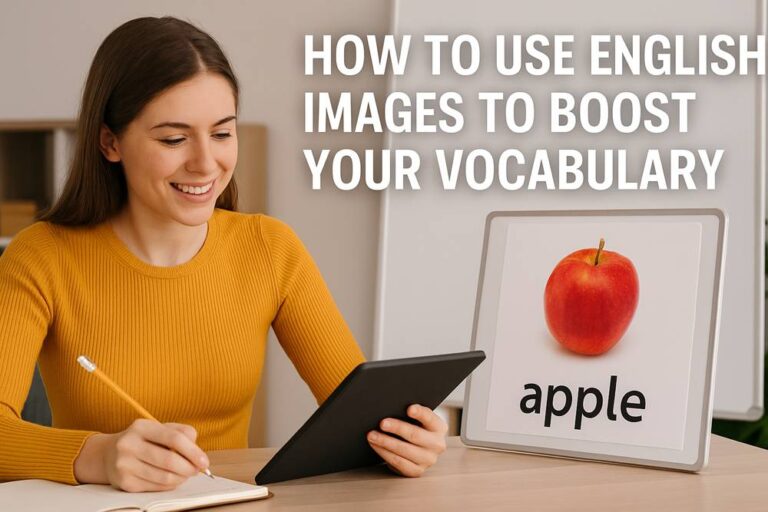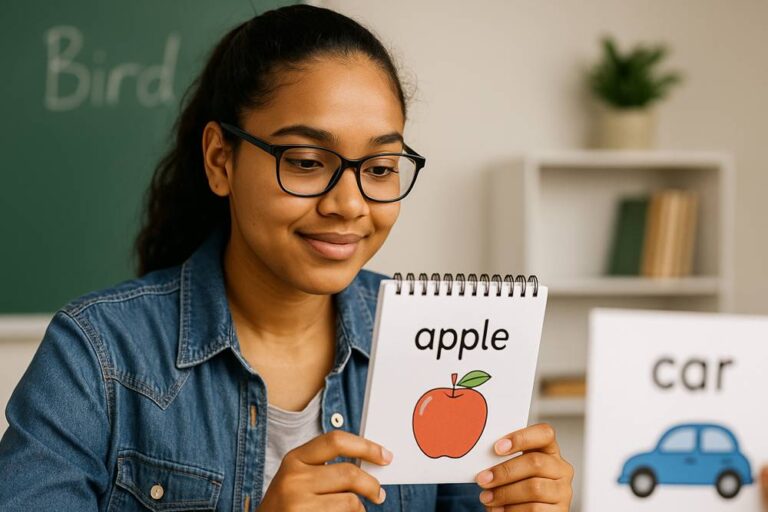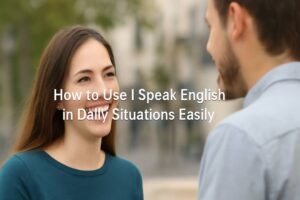Why English Images Help You Learn Faster 🌟
Have you ever looked at a photo of a cat with the word “cat” under it and remembered it instantly? That’s the power of english images! Learning vocabulary with visuals activates different parts of your brain, making it easier and faster to remember new words — especially for beginners.
When we pair a new word with a picture, our brain makes connections between the image and the meaning. This is called dual coding, and it’s one of the most powerful ways to build strong vocabulary memory. Whether you’re learning “apple,” “sky,” or “emotion,” seeing it in context helps it stick!
This is why many beginner English programs use vocabulary with pictures. For example, flashcards with a photo of a smiling person and the word “happy” help you instantly associate the emotion with the word — without translation.
You don’t have to use fancy materials either. Just try typing “English word + image” into Google or Pinterest, or use apps like Quizlet and Memrise. Even simple classroom posters or kids’ books like My First English Words use the english photo learning method.
If you’re looking to improve pronunciation with visuals, check out How to Have an American Accent with Natural Pronunciation — it pairs sounds with mouth movement photos, which is super helpful too!
Table of Contents
Types of English Images That Work Best for Learning 📷
Not all images are equally effective for learning vocabulary. Some visuals are too crowded or unclear, which can confuse learners. Let’s look at which types of english images actually help boost your learning.
1. Real-life photographs:
Clear, simple photos of objects or actions help with word recognition. Think “ball,” “run,” or “laugh” with real people and settings.
2. Illustrated visuals:
These are popular in children’s books and beginner ESL materials. They’re great for image based english learning because they often exaggerate key features, like a giant smiling sun for “sunny.”
3. Infographics:
Perfect for more advanced learners, infographics show relationships between ideas. For example, a chart that compares “tall, taller, tallest” with stick figures is easier to understand than a paragraph explanation.
4. English word visuals in context:
Seeing the word “delicious” next to a person eating cake gives context. This is the most natural way to internalize new vocabulary.
Visuals should be clean, labeled, and focused. Avoid clutter and try to keep one idea per image. You’ll remember better that way.
To deepen your understanding of word usage, read Best Word for Easy to Understand in English Writing. It offers great advice on word choice, especially for visual learners.

How to Make Your Own English Word Visuals 🧠
Want to personalize your vocabulary practice? One of the best ways is to create your own english images using your phone, Canva, or PowerPoint!
Here’s how:
Choose a word you want to learn (e.g., “bitter”).
Find or take a photo that shows it (e.g., someone drinking lemon juice and frowning).
Label the image with the word, pronunciation, and even a sentence (“The lemon tasted bitter.”).
You can save it in your notes app, print it, or upload to a private Pinterest board. This is especially helpful if you’re a teacher — creating visual english study materials tailored to your students’ needs helps them learn faster.
You can also involve friends or children in the process! Kids love making mini “English books” with pictures and stickers.
Creating your own visuals encourages active learning, which leads to better retention. If you teach English, check out Understanding Race in English Class and How to Teach It Well — it includes helpful examples of visual tools for difficult topics too.
Apps and Websites That Teach English with Images 📱
Many tools today are built on image based english learning — and the best part? Most are free or low-cost!
Top apps for English image learning:
Quizlet: Make your own flashcards with images.
Duolingo: Uses image-word matching for vocabulary drills.
Lingokids: Great for children learning with colorful images and animations.
BBC Learning English & VOA: Their vocabulary lessons often use clear photos with word examples.
If you prefer desktop learning, websites like ESL-Lab, Oxford Picture Dictionary Online, and EnglishClub.com have downloadable image sets and english word visuals sorted by category (food, travel, emotions, etc.).
You can also try Most Fun Languages to Learn and Why You’ll Love Them, which reviews apps that teach using images and music, especially for learners who get bored easily.
These tools are great for people who need visual english study without having to create everything from scratch. Just plug in and learn!

Using English Images to Practice Speaking and Writing 🗣️✍️
Did you know you can use english images to improve not only vocabulary, but speaking and writing too?
Here’s how:
Speaking: Pick a photo and describe it aloud. For example, “This is a picture of a man. He is riding a bicycle in the park.” This builds fluency and grammar confidence.
Writing: Look at a photo and write a short story or sentence using the word. Use this to create image-based journal prompts.
Group activity: Show an image and ask others to guess the word or describe it. This is great for classrooms or study groups.
This method is great for shy learners because the visual gives you something to talk about. You don’t start with an empty page — you start with a picture!
A great supplement is 5 Best Ways to Learn English Speaking for Real Conversations. Combine those tips with your image prompts and you’ll be speaking naturally in no time.
How Teachers and Parents Can Use English Images in Lessons 🧑🏫👨👩👧
For teachers and parents, using english images in lessons can make learning fun and effective.
Teaching ideas:
Morning picture board: Post 5 images and review the vocabulary daily.
Themed visual sets: Use flashcards for seasons, food, or emotions.
Label the room: Place images with words on furniture, windows, doors, etc.
Homework with photos: Ask students to draw or find pictures for their new words.
For children, pictures reduce anxiety. For teens or adults, images provide clarity and break the monotony of textbook-only learning.
Images are especially useful for multi-level classrooms. Beginners benefit from visuals while advanced learners can write descriptions or create image stories.
To support learners of all ages, visit Contact Us if you need custom image-based worksheets or want help using visuals in your curriculum.
Final Thoughts and Where to Learn More 💡
Using english images is one of the best tools for building long-term vocabulary. It makes learning feel less like memorization and more like play. Whether you’re a student, parent, or teacher, incorporating visuals can make a huge difference in your English journey.
Start small — choose 5 new words a week and find matching pictures. Build your own image bank. Share visuals with your study buddies. Even post them on your wall!
For more vocabulary and expression tips, visit Master Business English in 2025 or read about the English language on Wikipedia to explore its evolution through imagery and expression.
When words and visuals come together, your English becomes unforgettable.

How to Use I Speak English in Daily Situations Easily
Learn how to use i speak english confidently in daily conversations with phrases and simple speaking tips for real-life use.

How to Learn American Accent Fast with 5 Proven Tips
Learn how to learn american accent quickly through step-by-step pronunciation tips, listening habits, and practice drills.

How to Be Fluent in English and Use It Naturally Every Day
Learn how to become fluent in english with natural daily usage, conversation routines, and confidence building tips.
